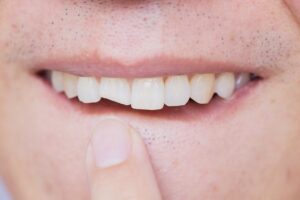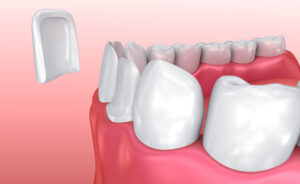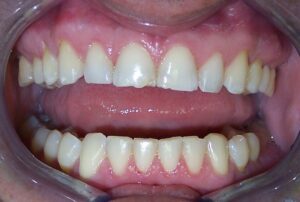How to Fix a Chipped Tooth
 One of the urgent dental problems we saw most frequently during our days of shelter-in-place was a chipped tooth. Thankfully, Dr. Ann was able to provide urgent dental care to those in need of quick repair. Because the severity of chipped teeth can vary widely, the treatment to repair them also varies widely.
One of the urgent dental problems we saw most frequently during our days of shelter-in-place was a chipped tooth. Thankfully, Dr. Ann was able to provide urgent dental care to those in need of quick repair. Because the severity of chipped teeth can vary widely, the treatment to repair them also varies widely.
Chipped Teeth Requiring Little to No Treatment
There are some cases of chipped teeth that require almost no treatment. If the chipped area is minor, does not expose the sensitive dentin underneath enamel, and does not have any sharp edges, you can choose not to repair it. For jagged areas with sharp edges, you can ask the dentist to reshape and smooth those edges to prevent irritation to your lip and tongue.
In cases of minor chipped teeth, treatment is at the discretion of the patient for cosmetic reasons.
Chipped Teeth Requiring Restoration
More commonly, chipped teeth do require repair to restore them back to normal appearance, health, and function. Obviously, we want to restore broken teeth in the front of the mouth to a cosmetically acceptable appearance. It is often necessary to restore chipped areas to protect the health of the tooth. When the chip removes an entire layer of enamel, The exposed dentin can be sensitive and at a higher risk for cavities. Replacing that protective layer of enamel with a dental material is important for the long-term health of the tooth.
We also must consider the function of the tooth. Front teeth serve the purpose of biting into and tearing food. Having a broken or uneven front tooth may impair your ability to bite through a sandwich or slice a pizza.
Composite Restorations (Tooth-Colored “Bonding”)
One option to repair a chipped front tooth is with dental composite material. Many people call this “bonding” (not to be confused with Bondo. . .). This material comes in a wide variety of colors, allowing Dr. Ann and Dr. Lauren to perfectly match and blend in with your natural tooth color.
This is the fastest and least expensive way to repair a chipped tooth. Those are the obvious advantages. There are a couple of important disadvantages, though. Composite restorations for chipped teeth have a tendency to chip or break off completely, especially if the patient has a clenching or grinding habit. Some people use their front teeth as tools, which is how they chipped the tooth in the first place. Composite bonding is not good for holding hair pains or cutting fishing line.
Porcelain Veneers
 Porcelain veneers can correct many different cosmetic problems with the front teeth, including chipped teeth. Porcelain veneers have more strength than composite material because they cover the visible portion of the tooth and wrap just over the biting edge. This increased coverage provides improved retention and longevity.
Porcelain veneers can correct many different cosmetic problems with the front teeth, including chipped teeth. Porcelain veneers have more strength than composite material because they cover the visible portion of the tooth and wrap just over the biting edge. This increased coverage provides improved retention and longevity.
While composite material simply fills in the missing tooth structure, a porcelain veneer covers the whole visible surface, allowing the dentist to make other cosmetic change to the tooth as needed. Porcelain veneers do not change the bite of the teeth.
Veneers are good treatment options for teeth that have lost a significant amount of tooth structure or teeth that require other cosmetic improvements in addition to repairing the broken area. Veneers are not great for repairing large cavities.
Porcelain Crowns
A porcelain crown covers the entire exposed tooth, from front to back, side to side, and biting edge to gums. With this amount of coverage, it’s simple to understand that crowns are capable of making big changes to a tooth. They can repair large chips, large cavities, and bite problems.
At Designer Smiles, we take pride in all of our cosmetic dentistry, and we commit to providing excellent dental treatments that will last. Dr. Ann and Dr. Lauren will recommend a dental crown when there is evidence to suggest the other treatment options will not be successful long-term. In many cases, we will perform a temporary repair with composite to provide a “quick fix”, with the understanding that the tooth will need full coverage with a crown for a long-term solution.
What Causes Chipped Teeth?
In general, we can break down the main causes of chipped teeth into two categories: 1) macrotrauma and 2) microtrauma. Don’t worry; we’ll explain what these terms mean.
- Macrotrauma – Macrotrauma is an injury that places a high amount of force on a tooth in an instant, causing the tooth to chip or break. This includes things like sports injuries, car accidents, and physical conflicts. If anything hits your tooth with a great amount of force, it can break the tooth. Macrotrauma is not always preventable. You can lower your risk by wearing a protective athletic mouthguard and your seatbelt.
 Microtrauma – Microtrauma is the consistent application of a relatively small amount of force over a long period of time. In dentistry, microtrauma is usually related to bruxism, or nighttime clenching and grinding habits. Over time, bruxism weakens the tooth and causes small fracture lines in the enamel. This weakened tooth structure is at risk for breaking under normal function. If you have broken a tooth while eating food that is not particularly hard, you probably had microtrauma on that tooth beforehand. Microtrauma is preventable by wearing a custom-made professional nightguard to protect against bruxism. If the biting edges of your front teeth look jagged or uneven, you probably have microtrauma and should consider having Dr. Ann and Dr. Lauren make you a protective nightguard.
Microtrauma – Microtrauma is the consistent application of a relatively small amount of force over a long period of time. In dentistry, microtrauma is usually related to bruxism, or nighttime clenching and grinding habits. Over time, bruxism weakens the tooth and causes small fracture lines in the enamel. This weakened tooth structure is at risk for breaking under normal function. If you have broken a tooth while eating food that is not particularly hard, you probably had microtrauma on that tooth beforehand. Microtrauma is preventable by wearing a custom-made professional nightguard to protect against bruxism. If the biting edges of your front teeth look jagged or uneven, you probably have microtrauma and should consider having Dr. Ann and Dr. Lauren make you a protective nightguard.
Are Some Chipped Teeth Too Bad to Repair?
Yes.
Unfortunately, some chipped teeth are so severe that dental treatment has a questionable long-term prognosis. This means that we cannot assure you that the treatment will last for any length of time. We are always able to take temporary measures to keep you smiling, but again, we want to ensure that our dental treatment lasts for many years.
Do You Have a Chipped Tooth That Needs Repair?
Call Designer Smiles today to set up a consultation appointment with Dr. Ann and Dr. Lauren. They can discuss the various treatment options with you and help you choose which one will best meet your needs.
